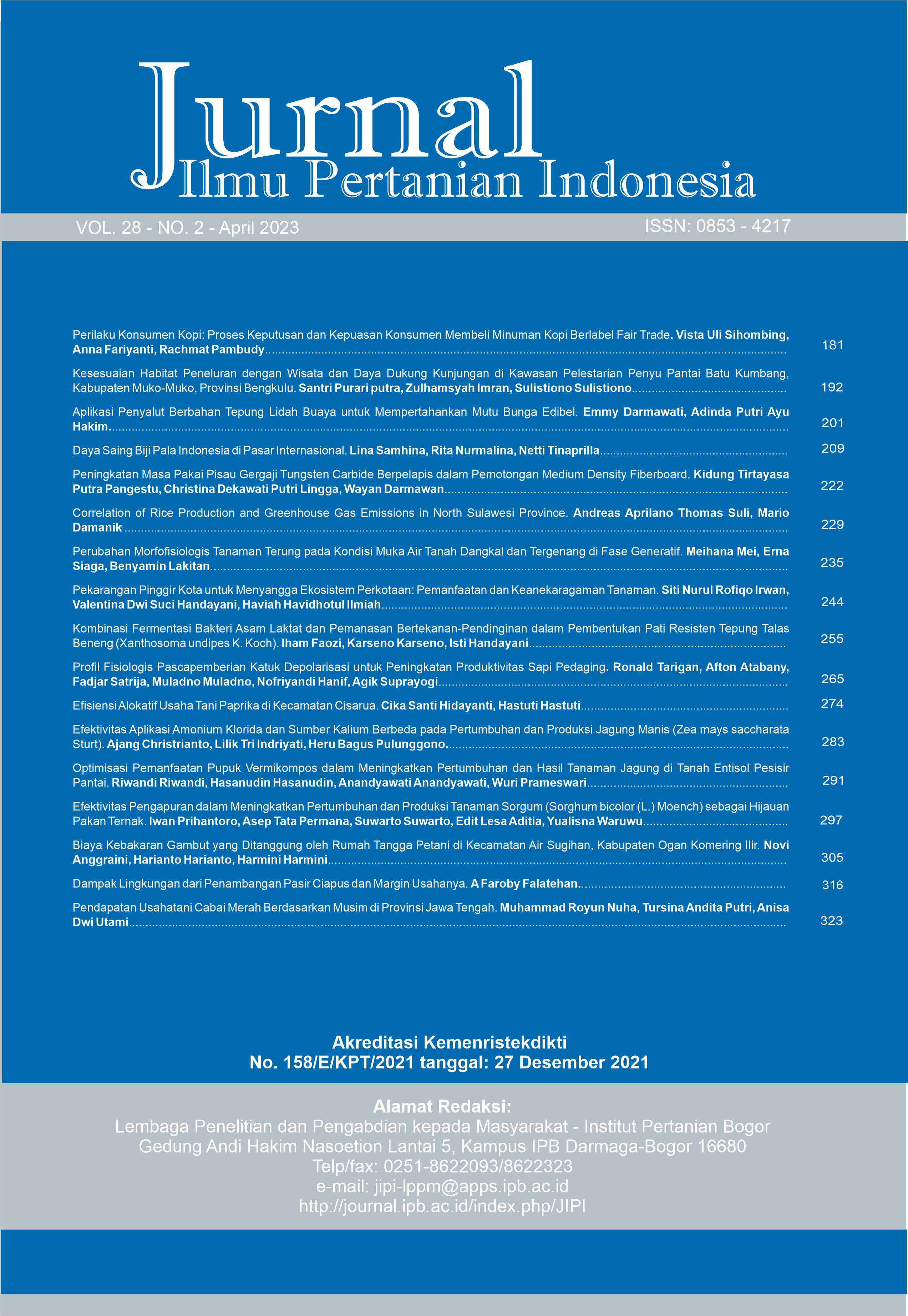Aplikasi Penyalut Berbahan Tepung Lidah Buaya untuk Mempertahankan Mutu Bunga Edibel
Abstract
Edible flower is a flower that is safe for consumption both in fresh and processed form. In fresh form, edible flowers are used as garnishes or food decorations and a unique flavor enhancer. Kenikir (Cosmos sulphureus) is one of the edible flowers that are safe for consumption in fresh form. However, in fresh condition, flowers are easily damaged so that their market share is limited. Coating using aloe vera, which can hold moisture while having antimicrobial properties, is a method to maintain flower freshness. The purpose of the study was to examine the effect of aloe vera coating application to maintain the quality of kenikir as a fresh edible flower. The experimental design used was a two-factor completely randomized design with the first factor being the concentration of aloe vera flour (0.5% and 1%) and the second factor being spray frequency (1 application and 2 applications). Quality parameters measured during storage were respiration rate, weight loss, moisture content, and color. The results showed that the coating with the L2S2 formulation (1% aloe vera flour concentration with 2 applications) was the best treatment with a weight loss value of 7.3%, water content 82.57%, respiration rate 898.99 ml kg-1 hour-1, and has the highest brightness value. Based on these parameters, the L2S2 treatment could maintain the quality of kenikir as fresh edible flowers for up to 5 days compared to the control, which lasted 2 days at 10°C storage temperature.
Keywords: aloe vera powder, coat spraying, Cosmos sulphureus, edible flower, kenikir flower
Downloads
References
Anjani IN. 2019. Pembuatan tepung berbahan dasar fillet lidah buaya (Aloe vera L.) untuk bahan coating produk pertanian [skripsi]. Bogor (ID): Institut Pertanian Bogor.
Asgar A. 2017. Pengaruh suhu penyimpanan dan jumlah perforasi kemasan terhadap karakteristik fisik dan kimia brokoli (Brassica oleracea var. Royal G) fresh-cut. Jurnal Hortikultura. 27(1): 127136. https://doi.org/10.21082/jhort.v27n1.2017.p127-136
Chrysargyris A, Nikou A, Tzortzakis N. 2016. Effectiveness of Aloe vera gel coating for maintaining tomato fruit quality. New Zealand Journal of Crop and Horticultural Science. 44(3): 203217. https:// doi.org/10.1080/01140671.2016.1181661
Cintya UD. 2016. Tingkat kesegaran bunga krisan potong yang direndam dalam campuran air kelapa dan larutan gula pasir dengan penambahan ekstrak buah belimbing wuluh. [skripsi]. Surakarta (ID): Universitas Muhammadiyah Surakarta.
Darmawati E, Sutrisno, Rusnaldi, Alfarizi WM, Nelida. 2016. Freshness Maintainance of Rambutan (Naphelium lappaceum L.) by Combination of Packaging Techniques with Aloe vera L. Based Coating. Proceedings The 2nd International Symposium on Agricultural and Biosystem Engineering. ISBN : 978-602-14315-2-8nd
Darmawati E, Putri RPS, Sutrisno. 2020. Menjaga Mutu Salak Madu dengan Aplikasi Coating Berbahan Komposit Gel Aloe vera-Beeswax Coating. Jurnal Hortikultura. 11(3): 15716 https://doi.org/10.29244/ jhi.11.3.157-165
Darmawati E, Ekawati M. 2022. Coating Application to Extend the Shelf Life of Sweet Potatoes cv. Cilembu. IOP Conference Series: Earth and Environmental Science, Volume 1038, The 4th International Conference on Agricultural Engineering for Sustainable Agriculture Production (AESAP 2021) 11/10/202111/10/2021 Online. IOP Conference Series: Earth and Environmental Science. 1038 012067. https://doi.org/10.1088/1755-1315/1038/1/012067
Fadda A, Amedeo P, Emanuela A, Salvatore D. 2020. Effect of modified atmosphere packaging on overall appearance and nutraceutical quality of pot marigold held at 5°C. Food Research International. Volume 134 (2020): 109248. https://doi.org/10.1016/ j.foodres.2020.109248
Guillen F, Mula HMD, Zapata PJ, Valero D, Serrano M, Castillo S, Romero DM. 2013. Aloe arborescens and Aloe vera gels as coatings in delaying postharvest ripening in peach and plum fruit. Postharvest Biology and Technology. 83(1): 5457. https://doi.org/ 10.1016/j.postharvbio.2013.03.011
Jagreeti G, Dubey RK. 2018. Factors Affecting Post-Harvest Life of Flower Crops. International Journal of Current Microbiology and Applied Sciences. 7(1): 548557. https://doi.org/10.20546/ijcmas.2018. 701.065
Kelley KM, Behe BK, Biernbaum JA, Poff KL. 2001. Consumer preference for edible-flower color, container size, and price. Hortscience. 36(4): 801804. https://doi.org/10.21273/hortsci.36.4.801
Mee GL, Lasekan O, Nazamid S, Khairunniza-Bejo S. 2018. Effect of chitosan and carrageenan-based edible coatings on post-harvested longan (Dimocarpus longan) fruits. Cyta–Journal of Food. 16(1): 490–497. https://doi.org/10.1080/19476337. 2017.1414078
Misir J, Brishti FH, Hoque MM. 2014. Aloe vera gel as novel edible coatings for fresh fruits [Review]. American Journal of Food Science and Technology. 2(3): 9397. https://doi.org/10.12691/ajfst-2-3-3
Putra DM, Yuswanti H, Darmawati IAP. 2016. Penggunaan chrysal untuk memperpanjang kesegaran bunga potong mawar (Rosa hybrida L.). Jurnal Agroekoteknologi Tropika. 5(4): 322-331. ISSN: 2301-6515
Reyes EO, Vazquez GM, Pompa SS, Montanez J, Molina RR, Zapata MAL, Herrera RR, Aguilar CN. 2013. Improvement of shelf life quality of green bell peppers using edible coating formulations. Journal of Microbiology, Biotechnology and Food Sciences. 2(6): 24482451.
Sanjamveer SV, Abbey L. 2019. Cut flower vase life–influential factors, metabolism and organic formulation. Horticulture International Journal. 3(6): 275281. https://doi.org/10.15406/hij.2019.03.00142
This journal is published under the terms of the Creative Commons Attribution-NonCommercial 4.0 International License. Authors who publish with this journal agree to the following terms: Authors retain copyright and grant the journal right of first publication with the work simultaneously licensed under a Creative Commons Attribution-NonCommercial 4.0 International License. Attribution — You must give appropriate credit, provide a link to the license, and indicate if changes were made. You may do so in any reasonable manner, but not in any way that suggests the licensor endorses you or your use. NonCommercial — You may not use the material for commercial purposes.























